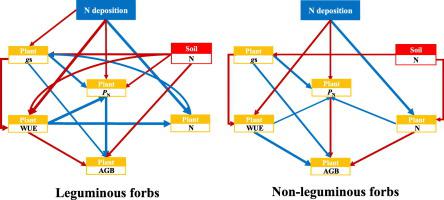Science of the Total Environment ( IF 8.2 ) Pub Date : 2020-06-30 , DOI: 10.1016/j.scitotenv.2020.140612 Hao Shen 1 , Shikui Dong 2 , Antonio DiTommaso 3 , Shuai Li 4 , Jiannan Xiao 4 , Mingyue Yang 4 , Jing Zhang 4 , Xiaoxia Gao 4 , Yudan Xu 4 , Yangliu Zhi 4 , Shiliang Liu 4 , Quanming Dong 5 , Wenying Wang 6 , Pan Liu 6 , Jiyu Xu 6

|
Increased nitrogen (N) deposition can affect ecosystem processes and thus influence plant eco-physiological processes in grasslands. However, how N deposition affects eco-physiological processes of leguminous and non-leguminous forbs in alpine grasslands is understudied. A long-term field experiment using a range of simulated N deposition rates (0, 8, 24, 40, 56, and 72 kg N ha−1 year−1) was established to examine the effects of N deposition on various eco-physiological parameters in leguminous and non-leguminous forbs in an alpine meadow of the Qinghai-Tibetan Plateau. We found that the responses of leguminous and non-leguminous forbs to simulated N deposition varied. Net photosynthetic rate of leguminous and non-leguminous forbs exhibited different response patterns, but chronic increases in simulated N deposition rates may lead to negative effects in both functional groups. Neither functional group responded differently in aboveground biomass under the highest N addition level (72 kg N ha−1 year−1) compared to the control. Differences in aboveground biomass of leguminous forbs were observed at intermediate N levels. Short-term simulated N deposition significantly promoted N uptake of both functional groups. In leguminous forbs, simulated N deposition affected net photosynthetic rates (PN) and aboveground biomass (AGB) mainly via stomatal conductance (gs), water use efficiency (WUE), and plant N uptake. In non-leguminous forbs, simulated N deposition affected PN and AGB mainly through WUE and plant N uptake. Our findings suggest that leguminous and non-leguminous forbs have differential response mechanisms to N deposition, and compared with non-leguminous forbs, leguminous forbs are more sensitive to continuing increased N deposition. The obvious decline trend in photosynthetic capacity in leguminous forbs is likely to exacerbate the already divergent ecological processes between leguminous and non-leguminous forbs. More importantly, these changes are likely to alter the future composition, function, and stability of alpine meadow ecosystems.
中文翻译:

在青藏高原高寒草甸中,生态生理过程对豆科植物中模拟氮的沉积比对非豆科植物更为敏感。
氮(N)沉积增加会影响生态系统过程,从而影响草地上的植物生态生理过程。但是,对于氮的沉积如何影响高寒草原豆科植物和非豆科植物的生态生理过程的研究尚未深入。使用一系列模拟的N沉积速率(0、8、24、40、56和72 kg N ha - 1 年-1的长期野外实验)的建立是为了研究N沉积对青藏高原高寒草甸豆科植物和非豆科植物的各种生态生理参数的影响。我们发现豆科植物和非豆科植物对模拟氮沉降的反应各不相同。豆科植物和非豆科植物的净净光合速率表现出不同的响应模式,但是模拟氮沉降速率的长期增加可能会导致两个功能组的负面影响。在最高氮添加量(72 kg N ha - 1 年-1)下,两个官能团对地上生物量的反应均不同)相比。在中等氮水平下,观察到豆科植物地上生物量的差异。短期模拟的N沉积显着促进了两个官能团的N吸收。在豆科植物中,模拟的氮沉积主要通过气孔导度(g s),水分利用效率(WUE)和植物吸收氮来影响净光合速率(P N)和地上生物量(AGB)。在非豆科动物的前叉中,模拟的N沉积会影响P N和AGB主要通过WUE和植物吸收氮来实现。我们的发现表明,豆科植物和非豆科植物对氮沉积的响应机制不同,与非豆科植物相比,豆科植物对持续增加的氮沉积更为敏感。豆科植物的光合能力的明显下降趋势可能会加剧豆科植物和非豆科植物之间已经不同的生态过程。更重要的是,这些变化可能会改变未来高山草甸生态系统的组成,功能和稳定性。











































 京公网安备 11010802027423号
京公网安备 11010802027423号